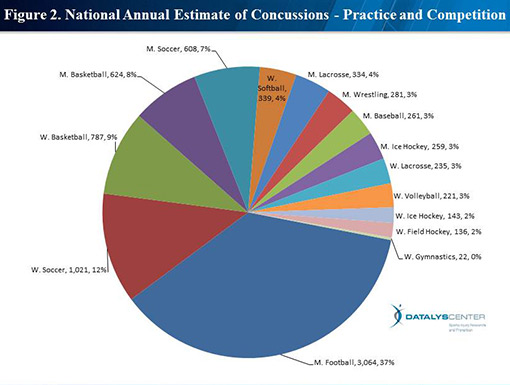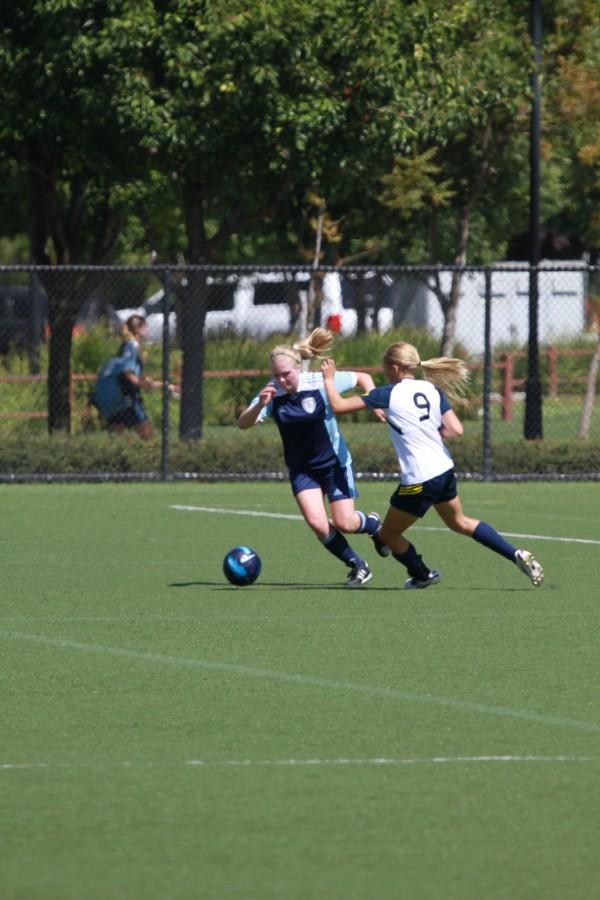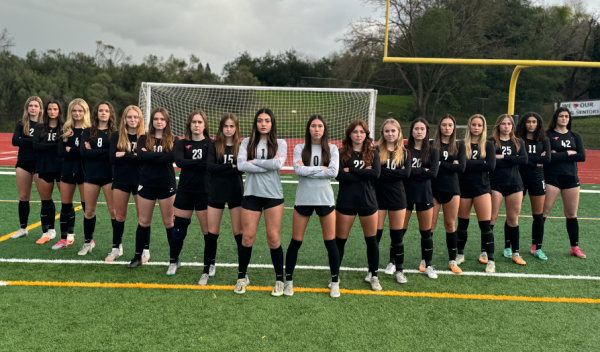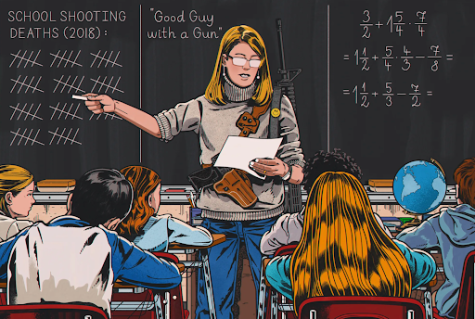Keeping Women’s Concussions in Mind
May 15, 2015
Although the number of concussions in football, and other men’s sports, are serious and deserve attention, there are other athletes that do not receive nearly enough attention for the number of head traumas that occur; these athletes are women.
Contrary to popular belief, concussions are much wider spread than just football, or in the NFL. There is tremendous coverage, with the hundreds of newspaper articles about safety in the NFL, head trauma, and the players that have been affected, but the world has just begun to realize the attention women’s sports need.
The Facts
Some people are unaware of the true definition of a concussion. Dr. Nash, a primary care pediatrician and credentialed ImPACT Consultant, says that a concussion usually occurs after some trauma has occurred to the head or brain. It does not need to be direct impact to the head, such as body to body.
“It’s not a bruise in the brain, it’s not anything structural that if you did a CT Scan or an MRI you would see,” Nash said.
It is a jarring to the head, and causes a metabolic disturbance. The electrolytes that are inside you nerves may leak out, and some electrolytes that are outside of the nerves leak in. These changes in metabolism in the brain are abnormal for about 7-10 days after the injury.
Because concussions are not visible, like a broken arm or a bruise, it is difficult for doctors, coaches, and even the player themselves to understand whether or not a headache is simply that, or something worse.
“The most obvious thing with someone who has been concussed are symptoms,” Nash said. “Dizziness, headache, people feel foggy, like they can’t concentrate well, things like that.”
Along with symptoms, doctors are now able to figure out whether a player has received a concussion by using base line testing. A form of this test is called ImPACT, which is taken on a computer.
The test evaluates memory, processing speed, and reflex time by asking athletes to perform tasks using shapes, letters, and words. The user must remember objects from previous tasks, and their score is used as a baseline for comparison when they show symptoms of a concussion. By using tests like these, doctors are able to more easily diagnose concussions, and the severity of them.
In order for these baseline tests to work, athletes must take the test before a head injury, when they are in a normal state. The awareness of concussions that the NFL has created has benefited student athletes, as that the population is becoming more focused on protecting both professional and students.
And by bringing more awareness to student athletes, it is opening the idea of researching more about female concussions, and why they are so prevalent.
The Stories
Concussions have impacted several students at Monte Vista. One of these students is Sierra Taylor, a sophomore who plays soccer, skis competitively, and does long jump. When she was just 12, she suffered her first concussion.
“I was going up for a header and another girl had already jumped up,” Taylor said. “She was coming down to the ground and I ended up hitting my forehead into her jaw.”
After the hit, Taylor continued playing, only thinking that she had received a bump on her head. However, minutes later, she had a pounding headache
“They got progressively worse, instead of getting better,” Taylor said, “I had trouble with my vision, and asked to sit down.”
A couple days later, the headaches still hadn’t halted, so she went to the doctor, and was told she had a minor concussion. After taking a couple days off from school, and a few weeks off of soccer, she had recovered.
“In soccer I was very tentative afterwards,” Taylor said. “Even in everyday life, if anything came towards my head, I would freak out. My playing was definitely affected.”
Not even six months later, Taylor received her second concussion. At soccer tryouts, she shot the ball and was struck by it after it had rebounded off the goalie’s hands. She was knocked off her feet, and received a bloody nose and black eye. She was immediately taken off the field, but kept trying to stand up and play again.
“ I wanted to go back into the game because it was tryouts, and I felt all this pressure to play, but I was really dizzy,” Taylor said.
This drive to continue playing is the reason why concussions can worsen over time.
“Those are the athletes that will often take 4 to 6 weeks to really recover,” Nash said.
Jordan Moldenhauer, a junior, suffered a major concussion last year that ended her soccer career and resulted in lasting issues.
In the first game of a Santa Cruz tournament, Moldenhauer was struck in the head after the goalie had punted the ball. After staying on the sideline for the rest of the game, she went to lunch and walked around Santa Cruz before her next game.
“We didn’t know anything was wrong [after the first game],” Moldenhauer said. “I had a headache, which isn’t an abnormal thing for me. We didn’t know it was going to be that serious.”
Because of this, Moldenhauer decided to play in the next game, where what ever had happened to her head during the first competition caught up with her. She passed out on the field, and continued blacking out 42 times before she was taken to the hospital.
Now, a year later, Moldenhauer still has long term effects from her concussion.
“For long term effects, I still pass out,” Moldenhauer said.
Because she never received baseline testing or a MRI before, the doctors are still unsure as to what occurred when Moldenhauer suffered her concussion.
Although Moldenhauer had to end her soccer career, she continues to run for track and field, where she can use her athletic skills without risking another concussion.
The Effect on School
While concussions generally occur during sports, they do not just affect an athlete’s ability to play, but they affect their daily life. For teenagers, school is a large part of their day, and with brain trauma comes frustration with keeping up.
Katie Bender, a freshman, had brain trauma this year after being hit in the head by the flyer during cheerleading. After being out of school for about a month, she found it frustrating to return.
“My learning had changed completely because I missed so many tests and quizzes and I didn’t know where to start,” Bender said.
Along with making up assignments, it is also a challenge to students with concussions to learn in the classroom. One of the common symptoms is becoming extremely sensitive to light and loud noises, both these common in classrooms. However, teachers at Monte Vista have been accepting, and try to work with the students.
“All of my teachers accepted the fact that I had to take it slow,” Bender said. “They didn’t give me as much homework, and they took their time to teach me everything I needed to know.”
Reading is also an issue, and made following along in English difficult for Jordan Moldenhauer.
“I couldn’t read, because my eyes couldn’t focus very well,” Moldenhauer said. “We would have reading assignments, and I wouldn’t have to do them.”
The issue with concussions is that unlike other sports-related injuries, head trauma dramatically affects your school life.
“When you are dealing with somebody’s leg, they may never run again or they may never play sports again,” Moldenhauer said. “But I am dealing with my head. My head has to do with sports, but it also has to do with school, which will have to do with my career in the future.”
With concussions affecting so much more than sports, it is essential that more research is conducted on why they occur. With the new spotlight on women’s head trauma, we are starting to get a better image of what is happening.
The Questions
Recent studies and statistics have shown that females have more concussions than males. A question several doctors are attempting to answer is why this is so.
“I see that in my own office,” Nash said. “I would almost say 75% of my concussion patients are female athletes.”
With soccer as the leading cause of concussions for women, these soccer players are two times more susceptible to concussions than male soccer players. With softball, females experienced double the rate of male baseball players.
Lacrosse also causes many, despite rules created in order to protect girls. Meanwhile, their counterparts do not have these limitations, and yet still manage to receive less concussions.
The real question is, why is it that girls are so much more likely to have brain trauma, and what is being done about it?
In the recent months, several theories have been formed. 
“One is that girls, and females in general, are a little more aware of their body,” Nash said. “And if they don’t feel right, they are more willing to share it with somebody.”
Generally, women tend to be more aware of what is normal for them, which could explain why so many concussions are reported from women. There is the possibility that boys are unaware, or do not want to tell anymore. If this is the case, there is another problem to be solved, which is that student athletes are not receiving help for there concussions.
Another theory is that since girls heads are generally smaller relative to their bodies, it is easier for them to receive a concussion.
“It really is a physics thing; when you have a smaller mass hitting against a larger mass, the smaller is more prone to having trauma” Nash said.
With the new research going on, other invalid theories have been thrown about, and then thrown away. One of these theories that was extensively evaluated and dismissed was the hormonal effect. It has been rejected, as that there was no higher or lower amount of concussions at certain times when hormones changed.
Whether the higher frequency of female concussions is attributable to williness to report them or physiology, these two theories are just the beginning of researching women’s concussions, and are a great start to understanding and preventing concussions in all athletes.















